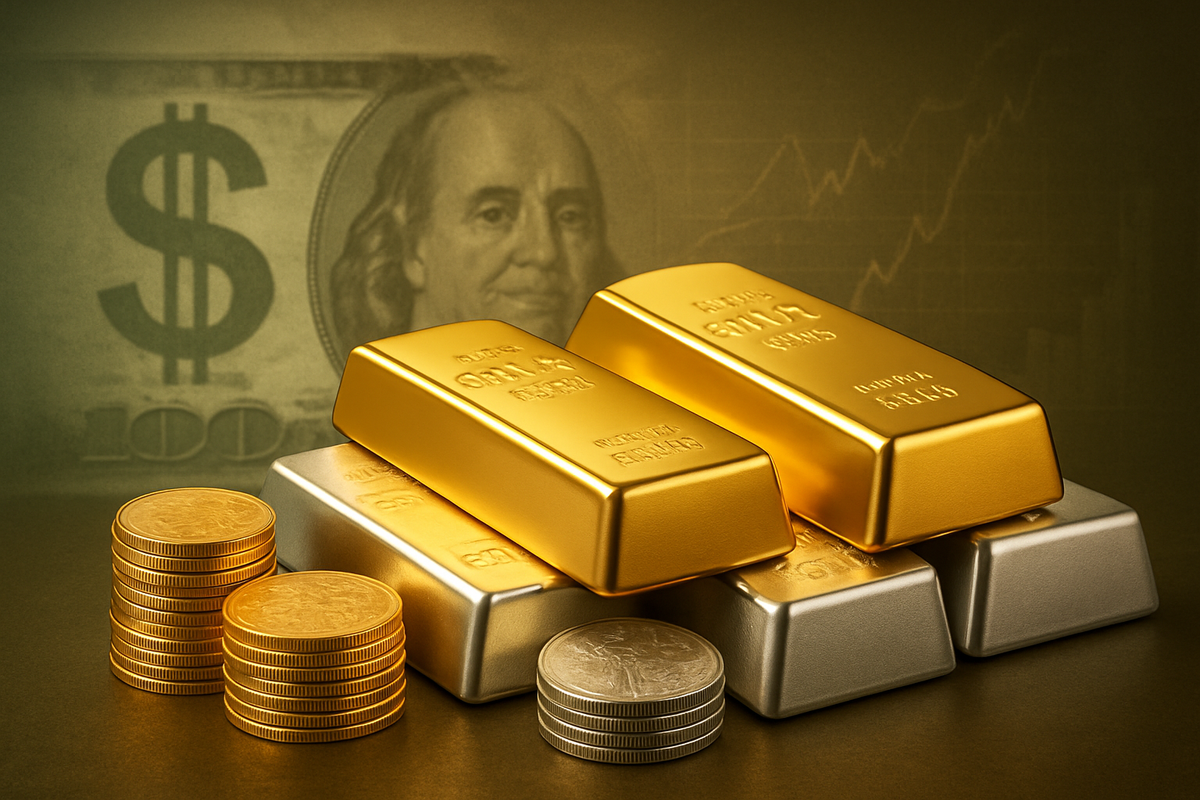
The global financial landscape is currently gripped by an extraordinary surge in the prices of gold and silver, a phenomenon primarily driven by a significant and sustained weakening of the U.S. dollar. As of November 6, 2025, both precious metals have reached unprecedented levels, reflecting a profound shift in investor sentiment towards safe-haven assets amidst a backdrop of escalating economic uncertainties and geopolitical tensions. This dramatic upward trend has immediate and far-reaching implications, reshaping portfolio strategies and signaling a potential recalibration of global financial dynamics, as investors seek refuge from currency debasement and inflation.
This surge underscores a growing lack of confidence in traditional dollar-denominated assets, compelling investors and central banks alike to diversify their holdings. The immediate implications include heightened demand for tangible assets, increased inflationary pressures, and a re-evaluation of risk across various asset classes. As the dollar continues its descent, the allure of gold and silver as reliable stores of value in turbulent times only intensifies, setting the stage for a potentially transformative period in the global financial markets.
Precious Metals Reach Historic Peaks Amidst Dollar's Decline
The year 2025 has witnessed an "extraordinary transformation" in the precious metals market, with both gold and silver achieving remarkable milestones. Spot gold, in particular, has shattered previous records, breaching the formidable $4,000 per ounce barrier to trade at an impressive $4,011.79 per ounce on November 6, 2025. This represents a staggering 44.5% year-to-date gain in USD terms by September 24, 2025, outperforming even high-flying assets like U.S. stocks, Bitcoin, and AI chipmakers since November 2024. Silver has mirrored this robust performance, reaching a 14-year high of $44.55 per ounce by September 24, 2025, and currently trading around $48.74 per ounce, steadily approaching critical historical resistance levels.
This powerful rally in precious metals is primarily attributed to a significant weakening of the U.S. dollar, which has experienced a dramatic downturn. The U.S. Dollar Index (DXY), a key measure of the dollar's value against a basket of major currencies, suffered its biggest loss since 1973 in the first half of 2025, declining nearly 11% and effectively marking the end of a 15-year bull cycle. As of today, November 6, 2025, the DXY stands around 99.8071, reflecting a 4.38% decline over the last 12 months. This depreciation is fueled by mounting fiscal uncertainty, with the U.S. national debt surpassing $37 trillion by August 2025, persistent inflationary pressures across consumer goods, housing, and energy, and broader geopolitical shifts contributing to a de-dollarization sentiment among global central banks. The anticipation of potential Federal Reserve interest rate cuts further narrows the interest rate differential, making non-yielding assets like gold and silver more attractive.
The immediate market reactions have been swift and pronounced. There's been a palpable "flight-to-safety" phenomenon, with investors abandoning riskier assets and flocking to gold and silver as stable stores of value. This inflationary environment, exacerbated by a weaker dollar increasing import costs, reinforces the demand for precious metals as natural hedges. While U.S. stocks and bonds have faced increased volatility and negative returns, American multinational companies with significant export revenues are seeing a boost due to more competitive pricing of U.S. goods and services abroad. Crucially, central banks worldwide are accelerating their gold purchases, diversifying their reserves away from dollar dependency, signaling a fundamental shift in global monetary strategies and ensuring sustained institutional demand for gold.
Corporate Winners and Losers in a Devaluing Dollar Environment
The ongoing surge in gold and silver prices, coupled with a weakening U.S. dollar, creates a clear dichotomy of winners and losers across various public companies. Understanding these dynamics is crucial for investors navigating the current market.
Gold and Silver Mining Companies are the most direct beneficiaries. As the market price of gold and silver rises, their revenue per ounce of extracted metal increases significantly, while their "all-in sustaining costs" (AISC) remain relatively stable. This operational leverage leads to expanded profit margins, higher cash flows, and increased profitability. For example, Newmont Corporation (NYSE: NEM), one of the world's largest gold producers, and Barrick Gold Corp. (NYSE: GOLD) stand to gain substantially. Canadian gold producer Alamos Gold (NYSE: AGI) has already demonstrated significant operating leverage, seeing substantial increases in revenue and free cash flow. Similarly, MAG Silver (TSX: MAG, NYSEAMERICAN: MAG), with its stake in high-grade silver mines, and Peruvian precious metals company Buenaventura Mining Company Inc. (NYSE: BVN) are poised for strong performance.
U.S. Multinational Corporations and Exporters also find themselves in a favorable position. A weaker dollar means that foreign earnings convert into a larger amount of U.S. dollars, boosting reported profits and revenues. Companies like McDonald's (NYSE: MCD) and Procter & Gamble (NYSE: PG), with substantial international earnings, benefit from these favorable currency conversion rates. Furthermore, a weaker dollar makes U.S.-produced goods and services more competitive abroad, potentially increasing demand and market share for exporters.
Conversely, U.S. Companies Reliant on Imports face significant headwinds. For businesses that depend on imported raw materials or finished goods, a weaker dollar translates directly to higher costs. This pressure on profit margins forces them to either absorb the increased expenses or raise prices, risking customer loss. Similarly, Gold and Silver Consuming Industries, such as jewelry manufacturers, electronics producers, and green energy technology companies, face escalating raw material costs. Industries utilizing silver for its conductivity in solar panels, electric vehicles (EVs), 5G networks, and AI hardware, including major players like Intel (NASDAQ: INTC), TSMC (NYSE: TSM), and First Solar (NASDAQ: FSLR), may need to implement recycling systems or hedging strategies to mitigate these rising input costs. Furthermore, high-cost precious metals miners, despite the overall bullish trend, may struggle to expand profits due to inefficient operations, while some financial institutions with significant short positions in silver could face substantial losses in a tight market.
Broader Implications and Historical Parallels
The current surge in precious metals, propelled by a weakening U.S. dollar, transcends mere market fluctuations, signaling a deeper re-evaluation of global economic and financial stability. This phenomenon is intricately woven into several broader industry trends, with significant ripple effects across the financial ecosystem.
Firstly, the escalating demand for gold and silver underscores their enduring role as safe-haven assets. Amidst pervasive economic uncertainty, persistent inflation, and geopolitical instability, investors are increasingly turning to these tangible assets for wealth preservation. This trend is amplified by concerns over currency debasement, as a weakening dollar erodes the purchasing power of fiat money, making precious metals an attractive hedge. The anticipatory monetary policy of central banks, particularly expectations of Federal Reserve interest rate cuts, further diminishes the opportunity cost of holding non-yielding assets, bolstering their appeal.
Secondly, a pivotal trend is the accelerated de-dollarization efforts by central banks globally. Emerging markets and BRICS nations are notably increasing their gold reserves, strategically diversifying away from dollar-denominated assets. This reflects a growing skepticism towards the stability of traditional fiat currencies and sovereign debt, leading to a fundamental realignment of global financial power. Gold now accounts for over 23% of official global reserves, surpassing the euro and yen, highlighting a structural shift in how monetary authorities view reserve assets. This has profound regulatory and policy implications, as central bank decisions on interest rates and quantitative easing directly influence the dollar's value and, consequently, precious metals. Mounting government debt and fiscal sustainability concerns, such as the U.S. national debt surpassing $37 trillion, further erode confidence in the dollar.
Historically, this scenario echoes the 1970s stagflation era, when the U.S. dollar lost substantial purchasing power, and gold prices surged nearly 30-fold, providing exceptional protection against inflation and currency devaluation. Similarly, the 2008 Financial Crisis and the 2020 Covid-19 Pandemic saw gold prices rise rapidly as investors sought stability during periods of global financial turmoil. These historical precedents reinforce the perception of precious metals as crucial safe havens during times of profound global change, indicating that the current market dynamics are not an anomaly but rather a recurring pattern driven by similar underlying economic and geopolitical pressures. The gold-to-silver ratio, which tends to narrow in crises, also suggests that silver, after an initial lag, could see even larger percentage gains than gold, as observed in the late 1970s.
The Road Ahead: Navigating a Shifting Financial Landscape
The outlook for gold and silver appears robust, underpinned by a confluence of economic, monetary, and geopolitical factors that suggest continued strength for precious metals in both the short and long term. Investors must consider strategic pivots and adapt to emerging market opportunities and challenges.
In the short term, the immediate boost from a weakening U.S. dollar is expected to persist. With gold having recently surpassed $4,000 per ounce, analysts predict further gains, potentially reaching $4,200 by year-end if anticipated Federal Reserve rate cuts materialize. While short-term volatility and periods of price consolidation are likely, these are generally viewed as healthy corrections rather than reversals of the upward trend, offering opportune entry points for renewed buying interest.
The long-term possibilities for gold and silver remain exceptionally strong. Persistent inflation and concerns about currency debasement will continue to drive investors towards precious metals as essential hedges. The ongoing strategic accumulation of gold by central banks, driven by de-dollarization efforts and geopolitical tensions, provides a fundamental floor for prices and signals sustained institutional demand. Furthermore, silver's dual role as a safe haven and an industrial metal, with accelerating demand from sectors like solar energy and electronics, provides an additional tailwind. J.P. Morgan Research, among others, maintains a "structural bull case" for gold through 2025 and 2026, with forecasts ranging up to $5,600 per ounce by 2026.
Strategic pivots for investors should include increasing portfolio diversification by allocating a portion to gold and silver (potentially higher than traditional 5-10%), considering physical holdings for wealth preservation outside traditional banking systems, and exploring targeted exposure through gold mining equities or hedging strategies. Diversifying into global equities, particularly in export-driven economies and emerging markets, can also help capture opportunities arising from a weaker dollar. While opportunities abound in safe-haven appeal, central bank buying, and industrial demand for silver, challenges include potential volatility, the risk of a rapid economic recovery diminishing safe-haven demand, and unexpected dollar strengthening.
A New Era for Precious Metals: Investor Watchpoints
The current surge in gold and silver prices, fueled by a weakening U.S. dollar, signifies more than a transient market trend; it marks the dawn of a new era for precious metals in the global financial system. This profound shift is a direct consequence of persistent fiscal uncertainties, inflationary pressures, and a fundamental re-evaluation of currency stability and risk by investors and central banks worldwide.
Key takeaways from this event include the reassertion of gold and silver as indispensable safe-haven assets, their crucial role as hedges against currency debasement and inflation, and the accelerating trend of de-dollarization among global monetary authorities. The market is moving towards a more diversified, multipolar currency system, with gold playing an increasingly central role as a reserve asset. This has significant implications for traditional portfolio construction, challenging the long-held dominance of dollar-denominated assets.
Moving forward, the market is likely to remain highly dynamic, characterized by continued strength in precious metals, albeit with periods of volatility. Investors should assess their portfolios for resilience against currency fluctuations and inflation, considering increased exposure to tangible assets. The sustained institutional demand from central banks provides a strong underlying support for gold prices, suggesting that any pullbacks may be temporary buying opportunities rather than signs of a reversal.
What investors should watch for in the coming months includes further developments in Federal Reserve monetary policy, particularly any signals regarding interest rate adjustments. Key economic indicators such as inflation reports, U.S. national debt figures, and global trade balances will offer insights into the dollar's trajectory. Geopolitical events and central bank actions, especially continued gold accumulation by non-Western nations, will also be critical indicators of the ongoing shift in global financial power. This period demands vigilance and strategic adaptation, as the landscape of global finance continues to evolve under the influence of a weakening dollar and the rising prominence of precious metals.
This content is intended for informational purposes only and is not financial advice





